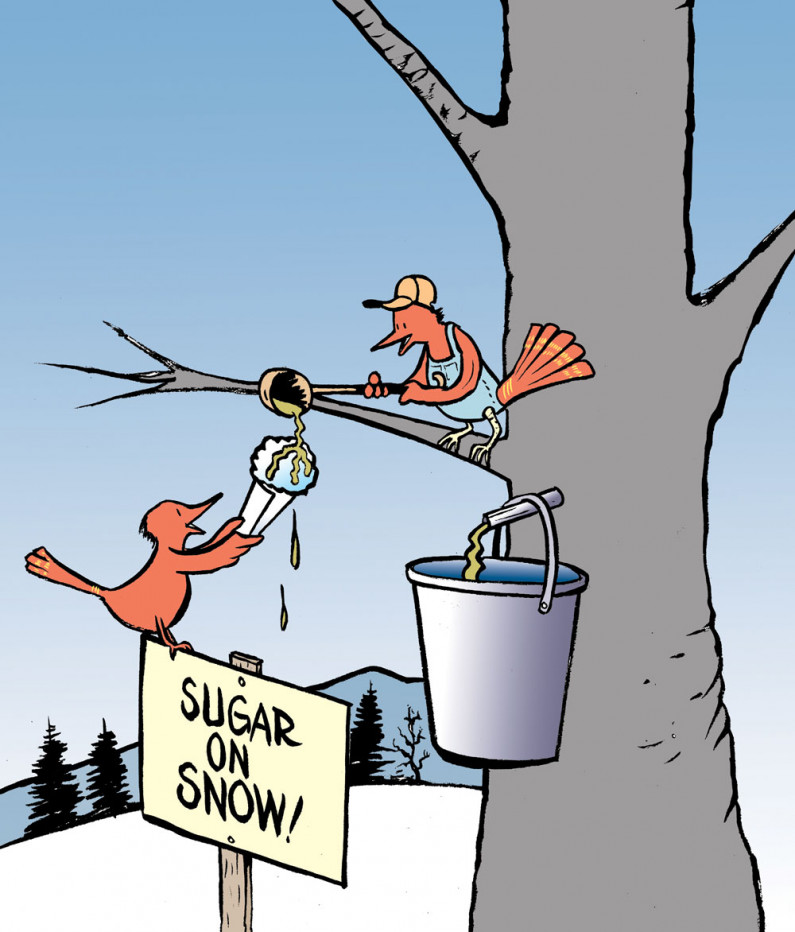Syrup for the Birds: Bird Friendly Maple Project

Cartoon by Tim Newcomb
Vermont Maple Syrup. It’s something we’re proud of in this state. It is, in fact, one of our most famous exports. It calls up images of pancakes doused in rich amber, sugarhouses full of sweet steam, and boots tromping through the forest to collect the sap that drips from trees into galvanized buckets with a steady plunking sound, like a leaky faucet. It doesn’t usually call up images of song birds.
Audubon Vermont would like to change that. In 2013, with the help of a $15,000 Innovations and Collaborations grant from the Community Foundation, Audubon teamed up with Vermont’s Department of Forest, Parks, and Recreation and the Vermont Maple Sugar Maker’s Association to launch the Bird Friendly Maple Project, an effort to encourage sustainable sugarbush management practices.
High demand for maple syrup has tempted some producers to remove non-maple trees from their sugarbushes—it’s a good strategy to maximize sap production, at least in the short term. But it leaves something out.
The sugarbush is a forest ecosystem that provides multiple benefits, including homes for many kinds of birds. And maple monocultures provide lower quality habitat than a sugarbush with a variety of tree species. Birds thrive best in environments with lots of different nooks and crannies to hide, forage, and raise their young. They need structural diversity—different sizes and shapes of plants, rocks, fallen logs, and so on. And they need biological diversity—different species of plants and insects and other critters to eat and share resources with.
That same structural and biological diversity that is better for the birds is also better for the trees. According to Audubon Vermont Conservation Biologist Steve Hagenbuch, sugarbushes made up of at least 20% tree species other than sugar maple are less likely to suffer major losses from sugar maple insects or diseases. And growing young trees under the older ones offers great places to nurture baby birds, while ensuring a future for the bush. Biodiversity increases the resilience of the forest over the long term, in part by providing healthy habitat for the birds that help manage insect populations and other potential threats to forest health. These things, in turn, are also ultimately better for the humans who harvest from the woods.
In short, the health of the birds can be an indicator for the health of the forest overall.
“When our maple bush was hard hit by the forest tent caterpillar invasion a number of years ago, we noticed the presence of an unusual number of cuckoos,” says Hidden Springs Maple Farm in Putney. “We eventually learned that the cuckoos were there to eat the forest caterpillars. This led us directly to an appreciation of the importance of a balanced approach to forest management.”
In Vermont, we value our approach to the working landscape, and that includes our woods. For many, this means that supporting sugar makers who build the resilience of their sugarbush is a worthwhile endeavor. Audubon and their partners have begun to develop sugarbush management criteria and bird-friendly product branding to encourage the purchase of maple products from producers who practice sustainable sugarbush management. And that initial $15,000 grant from the Community Foundation helped the partners leverage an additional grant of $75,000 from the Canaday Foundation to expand the project.
Someday soon, a hearty breakfast of pancakes, or a stocking stuffed with maple candy, will call to mind not only sneaking a ladle full of sap from the tap down the road, but also the songs of Vermont’s birds.
Learn more about the Bird Friendly Maple Project.